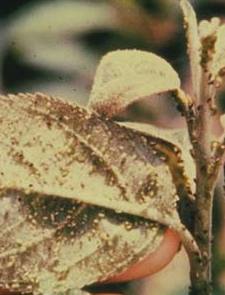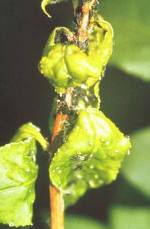Categories
Calendars
Guides
Reviews
Archive
Gallery
Articles
Ask Our Gardening Expert
Aphid Control (Greenfly and Blackfly)
Aphids are one of the commonest and most troublesome of all garden insects, attacking a large number of garden plants such as the rose, many trees and vegetables. Greenfly and blackfly are aphids and they suck the sap of the plant. They are particularly attracted to young tender shoots. This causes the shoots and leaves to become distorted. It is unlikely to kill the plant, but it can seriously weaken it.
GO TO
THE GARDEN PEST AND DISEASE MAIN PAGE FOR
PESTS AND DISEASES CLASSIFIED BY PLANT

Aphid Control and Treatment
There are many species of aphids but almost all respond to the same control and treatments. A large variety of chemical sprays are available from your garden centre to treat aphids, but all will have some bad affect on other beneficial insects and wildlife.
Where edible crops are sprayed with these chemicals, some of the chemical will also remain within the flesh of the plant.
A better line of attack is to encourage other insects which feed on aphids. Research has very positively shown that planting certain plants (e.g. tagetes, calendula, poached egg plant, morning glory) near the plants which are often attacked by aphids results in much lower numbers. The aphid's enemies include hoverflies, ladybirds, lacewings and birds.
The important point to consider with attracting beneficial insects is that those insects rely on a steady source of aphids. When the aphid population drops below a certain level, the insects will go elsewhere. This in turn will allow the aphids to multiply. The solution to this problem is the humble nettle.
There are a couple of reasons why nettles are so good for protecting your plants. Firstly, they will attract the nettle aphid which is a good source of food for lots of aphid eating insects. Nettle aphids are also one of the earliest to appear in the year which is good news for the ladybird. Nettle aphids won't attack your other plants because they only feed on nettles. So, not all aphids are bad news!

The picture on the right is of aphids colonising a plant and causing typical damage. The leaves curl inward effectively protecting the aphids from insecticidal spray.
They tend to attack tender young shoots, emerging leaves and twigs.
The commonest varieties are whitefly and greenfly. As well as causing damage on their own behalf they encourage other pests and diseases.
The reason some flowering plants help prevent aphids is clear, the plants are the feeding favourite of the hoverfly. Hoverflies have short feeding tubes and they prefer plants have flat and open flowers. This helps the hoverfly to easily reach the pollen. After feeding, the adult hoverfly will then lay her eggs on colonies of greenfly and black fly. When the eggs hatch, the resulting larvae feed on the aphids with dramatic effect! Try it, it really does work.
Other friendly ways of controlling aphids include rubbing them off with your fingers, spray them off with water and the use of insecticidal soap (a potassium-salt soap available at most garden centres). Many people have success by spraying weekly with very diluted washing up liquid - about one teaspoon of Fairy Liquid to a couple of litres of water.
Aphids breathe through their skin. Spraying with diluted washing up liquid clogs up their skin and causes them to literally suffocate. Their brains are unable to detect pain according to the majority of research, so don't worry unduly about any pain this may cause!
A superb present
for all gardeners.
Click below to
buy this book at a great price.